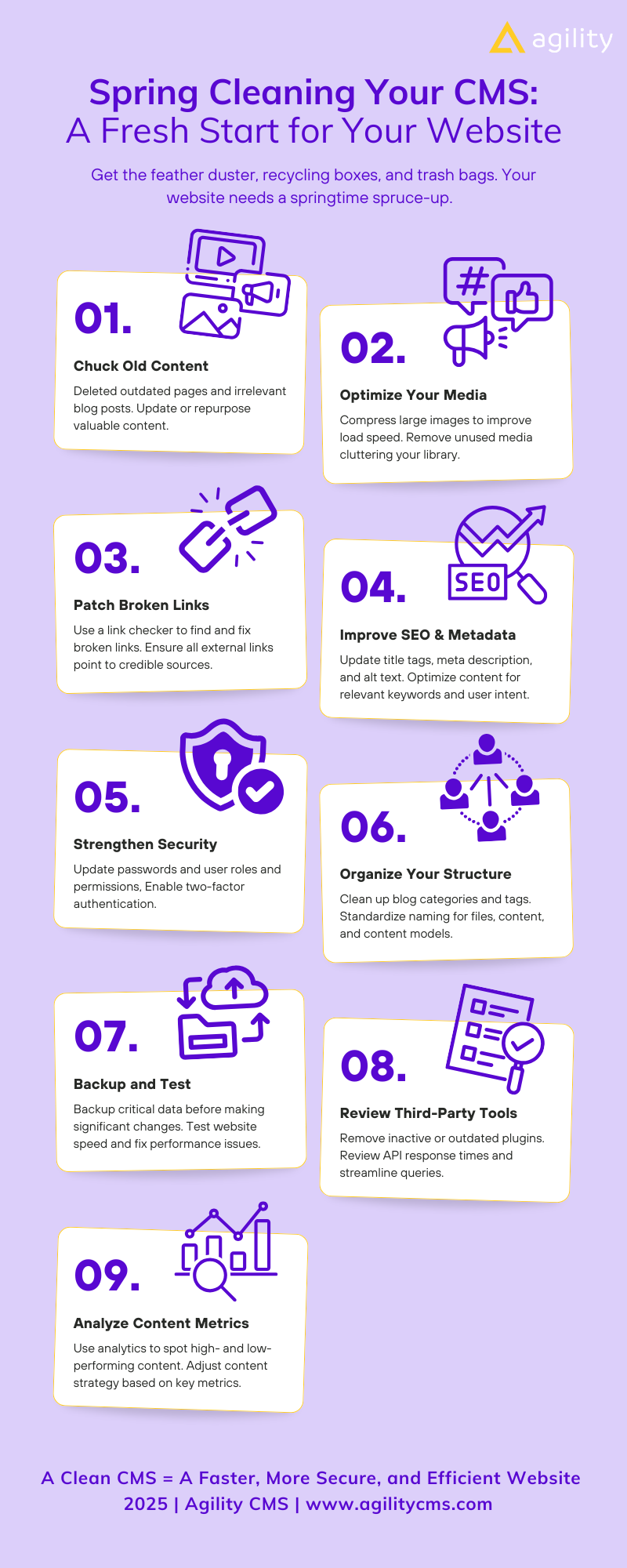Time for a Digital Declutter: Spring Cleaning Your CMS (Infographic)
A clean CMS is a secure and efficient CMS


Finally, spring has arrived. Across Canada, 86% of Canadians say they plan to partake in spring cleaning activities, with the living rooms, bedrooms, and kitchens being the primary focus.
The room-by-room approach works with any home, no matter how big or small. And if you take the same approach to your website, you can give it a thorough spring cleaning too.
Your Website as a House
Your content management system (CMS) is the entryway to your website. Like the front door of a house. Once inside, your website functions like a home:
- Web pages are rooms. Key pages (homepage, product pages) are frequently used, while pages like archived blog posts (storage closet) and obsolete landing pages (attic) are rarely visited.
- Content is furniture and décor. Well-organized, useful content makes a page inviting. Clutter, or sparse content, drives visitors away because it’s uncomfortable.
- Navigation is the hallways. Clear, easily understood pathways help users move smoothly between pages. Overly complex menus or broken links create dead ends and frustrate users.
A well-maintained website, like a tidy home, is welcoming and easy to navigate. And if your website could use a springtime spruce-up, check out this infographic for smart tips, or scroll down to find out more.
Spring Cleaning Your CMS: A Fresh Start for Your Website
Looking to brighten up your website to match the spring weather and blooms? Here are nine tips that are easier to execute than cleaning windows (ranked by 46% of Canadians as the hardest spring cleaning task) or the bathroom (42%).
-
Chuck Old Content
If old web pages or blogs are no longer relevant or useful – and aren’t getting any traffic – delete them from your website. Conversely, update or repurpose valuable content to give it a fresh look and feel.
-
Optimize Your Media
Large images may look sharp, but they also slow down website speed. Compress large images to improve load speed. While you’re at it, remove old videos, images, or icons that do nothing but clutter up your library.
-
Patch Broken Links
In your house, dust bunnies are hiding everywhere. On your website, broken links may be everywhere. Use a link checker to find and fix them. Ensure external links point to reputable, credible, and trustworthy sources.
-
Improve SEO and Metadata
Go into your title tags, meta descriptions, and alt text and ensure they’re filled with relevant, keyword-rich text. Speaking of keywords, make sure your content is also optimized for keyword relevancy and user intent.
-
Strengthen Security
An eight-character password can be broken in 37 seconds. A 16-character password takes over a century. Update any 123456 passwords you have. Also, enable two-factor authentication for greater security.
-
Organize Your Structure
Do you need all those categories and tags for your blog? No? Now’s a good time to clean those up. Also, make certain files, content, and content models follow standardized naming for easier access and organization.
-
Backup and Test
Before making any big changes to your CMS or website, be sure to backup critical content…just in case. Test website speed, too. If you’re in eCommerce, each second delay can result in a 7% drop in conversions.
-
Review Third-Party Tools
If you’re using plugins, eliminate any inactive or outdated plugins. If you’re using APIs, review response times and streamline queries. Also, remove unnecessary API calls to improve overall speed.
-
Analyze Content Metrics
Is your content doing anything for you? Use analytics to identify high- and low-performing content. Then, adjust your strategy accordingly based on your key metrics, such as engagement, clicks, or conversions.
Clean and Organize Your Content with Agility CMS
Agility CMS is the headless CMS that takes your content from overwhelming to organized. Whether your website has 10 pages, 100 pages, 1000 pages – or more – Agility makes it easy to take control of your content. Here’s how:
- Declutters Content: Content and design are separate, so everything is neatly stored and managed.
- Creates Smart Storage: Content is centrally stored, avoiding scattered or mismatched copies.
- Solid Structures: Efficiently categorize and tag content for quick access.
- Eliminates Old Content: Archive, update, or remove content that’s no longer useful.
- Easy Distribution: Push fresh content to multiple platforms at once.
Ready to begin spring cleaning your CMS with Agility? We’re ready to help.
|
Get a DemoLet us show you how easy content management can be.
|
Try for FreeSee for yourself how you can take control of your content. |
Contact Us NowReach out to us with your questions and we’ll reply ASAP. |

About the Author
Mauro Flammini is the Content Manager at Agility CMS. He has over 20 years of content marketing experience, including for international brands such as Research In Motion and Intuit. He lives in Hamilton, ON with his wife, two daughters, and one dog.


